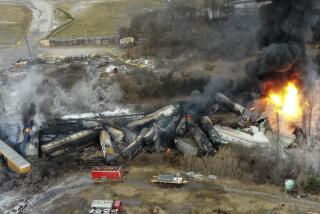Sport-Utility Vehicles to Get New Labels on Rollover Risk
- Share via
WASHINGTON — Addressing growing safety concerns about hot-selling sport-utility vehicles, the government today will announce a requirement for dramatic warnings about the danger of rollovers.
The National Highway Traffic Safety Administration will direct auto makers to post a graphic new label--showing a lurching SUV with two wheels high in the air--on the front of the sun visor or the driver’s side window of new models.
The agency said that its action is a first step in a larger effort directed at SUVs, which have boomed in popularity in recent years, appealing to Americans from suburban mothers to young city dwellers. Los Angeles, according to the Polk Co. market research firm, is the top national market for large SUVs like the Ford Expedition. Overall, SUVs account for 18%, or nearly 1 in 5, of all new vehicles sold.
The high-riding vehicles offer occupants a better view of the road and an enhanced feeling of security. But statistics show that SUVs are more prone to flipping over on curves at high speed and in crashes. The danger from instability is compounded by the fact that SUV occupants--many of them young men--are also less likely to wear seat belts.
“People involved in crashes tend to be risk-takers,” a traffic safety agency spokesman said.
Nearly 1,500 people were killed in SUV rollovers in 1997, the most recent year for which statistics are available. According to the National Safety Council, 43,200 people died in traffic accidents that year.
In single-vehicle accidents, which account for about half of all fatal crashes, SUVs rolled over 49% of the time, compared with 17% of the time for cars, 22% for vans and 38% for pickup trucks. More than 70% of the 1,482 SUV occupants killed in rollovers in 1997 were not wearing seat belts.
“Even if occupants are wearing seat belts, rollovers are still pretty violent crashes,” said Julie Rochman, spokeswoman for the Insurance Institute for Highway Safety. “We support a better label, but it’s not nearly enough--it needs to go further.”
Agency officials said they hope to release a safety standard later this year that will set minimum stability requirements for all sport-utilities. The agency is also considering requirements for crush-resistant roofs, shatter-proof windows to keep occupants from being tossed out in a crash and high-backed seats that would provide the same kind of protection as a roll bar when an SUV flips.
“Buying an SUV involves a trade-off,” Ricardo Martinez, administrator of the traffic safety agency, said in a statement. “While these vehicles may do well in certain types of crashes, they are also more likely to roll over. People should be aware of that trait when they are choosing a family vehicle.”
The traffic safety administration has been test-driving SUVs to gain a better understanding of how rollover crashes happen. Martinez said test results may be used to create a consumer information program that would assign a “rollover rating” to each SUV model, in addition to the crash-test safety ratings that the agency now issues for all passenger vehicles.
Consumer and insurance industry groups, however, regard new warning labels as too timid a step and are urging the government to move ahead with the rest of the safety requirements it is considering.
“A label is just telling the driver what we already know: that these kinds of vehicles have a tendency to roll over,” said Gerald Donaldson of the nonprofit Advocates for Highway and Auto Safety.
The current federal safety label for SUVs has been unchanged for 20 years. Designed before the age of graphics, it consists of an 80-word block of text. There is no requirement on where to place it, though many auto makers affix it to the sun visor.
The industry did not oppose a stiffer warning label outright and succeeded in convincing the agency not to use a more alarming graphic that depicted a human figure going through the window. Auto makers argued that people get tossed out of SUVs in crashes because they do not buckle their seat belts, not because of an inherent defect in the vehicles.
The new label is terse. It reads: “WARNING: Higher Rollover Risk.” It adds below: “Avoid Abrupt Maneuvers and Excessive Speed.” The government’s new rule also will require that safety information in driver manuals be made easier to understand.
Morry Markowitz, a spokesman for the Assn. of International Automobile Manufacturers, said: “The vehicles manufactured today are safer than ever. The industry has already provided an incredible amount of information to consumers.”
The other SUV safety issues that concern the government, such as a rollover rating system, are expected to be more contentious. But a traffic safety agency official said that the industry has cooperated with the government thus far partly because a better reputation for safety would help keep sales of the vehicles strong.
SUVs represent the fastest-growing segment of the new vehicle market. According to J.D. Power and Associates, the 18% of new vehicle sales they represented last year was an increase from 10% as recently as 1993. In 1998, Americans bought 2.8 million new sport-utility vehicles, more than 300,000 of them in California.
As their popularity has grown, so have concerns. SUVs get lower gas mileage than passenger cars. And heavier SUVs inflict disproportionate damage in crashes with passenger cars. Recent government studies have shown that design changes in SUVs have made them less punishing in crashes. Rollovers, however, remain a major issue. Last week, the traffic safety administration announced that three SUVs had flipped over in crash tests.
Times staff writer Judy Lin contributed to this story.
(BEGIN TEXT OF INFOBOX / INFOGRAPHIC)
Vehicle Rollover Rates
Percentage of vehicles that rolled over in single-vehicle accidents.
Sport Utility Vehicles: 48.9%
Pickup trucks: 37.5%
Vans: 22.2%
Cars: 17.4%
Source: National Highway Traffic Safety Administration






